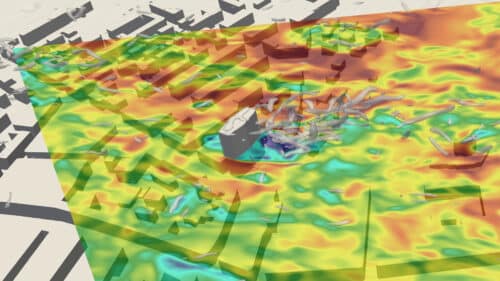- A turbulence modelling technique reshapes how massive structures interact with the natural dance of the wind.
- A fresh wave of precision fueled by the latest technology marks a paradigm shift into an era where accuracy reaches unprecedented heights.

In a stride toward more accurate building design, Danish company Vind-Vind has introduced an innovative turbulence modelling technique that promises to reshape how large structures interact with natural wind conditions. Conventional methods of constructing sizable edifices rely on scale models tested within wind tunnels. These simulations often fall short in estimating peak loads, necessitating safety buffers.
The company’s approach stems from recognising the limitations of unidirectional wind tunnel testing, which fails to replicate real-world scenarios involving multidirectional gusts and eddies. To address these shortcomings, the company has a turbulence model leveraging real-world data gathered by a Light Detection and Ranging (LIDAR)system employing 10 ns pulses. The emitted laser is reflected off airborne particles, with Doppler effect-induced alterations in the returned light meticulously analysed using Spectrum Instrumentation’s state-of-the-art M5i.3321 digitiser card.
CEO Per Jørgensen said, “Currently, wind movement is gauged using either low-resolution data covering several kilometres or high-resolution measurements limited to a few hundred meters. Our LIDAR-based instrument excels in capturing high-resolution data across extensive distances.” Spectrum’s digitiser card is central to this innovation, boasting an l 3.2 GigaSamples per second sampling rate and 12-bit resolution. This bandwidth accommodates fluctuating conditions and faint signals while facilitating noise reduction during data processing.
Dealing with the copious data generated by tracking numerous wind-blown particles demanded an ingenious solution. While initially contemplating field programmable gate array (FPGA), the company deemed the programming complexity and insufficient computational power unsuitable. Their quandary was resolved with Spectrum’s SCAPP drivers (Spectrum’s CUDA access for parallel processing). The M5i digitiser, equipped with a 16-lane peripheral component interconnect express (PCIe) interface, channels data—up to a staggering 12.8 GigaBytes per second—to a CUDA-based graphics card, sidestepping the PC’s CPU. The Nvidia Quadro A4000 graphics card, housing 6,144 cores, outpaces typical CPUs with a mere 6 or 8 cores.
The company’s foremost objective entails scrutinizing turbulence congruence between measured and computer-simulated urban environments. Subsequent enhancements will encompass higher atmospheric levels, incorporating diverse wind gusts. Real-world data validation will ultimately underpin the accuracy of their 3D wind modeling, proving instrumental in heightening safety, wind comfort, and sustainability while mitigating excess material usage due to inaccuracies in wind tunnel modeling.
Jørgensen enthused, “Our 3D wind modeling, grounded in proven accuracy, forecasts the intricate realities of the natural world, departing from the confined wind tunnel paradigm. This transformation stands to curtail architects’ overcompensation, fostering sustainability and cost savings by optimizing resource utilization.” They envisions their model’s applicability in scenarios where traditional wind tunnel tests falter—like intricate atmospheric interactions in urban environments, wind turbine clusters, bridges, and airports. This leap indeed heralds a new era in architectural and engineering precision.







